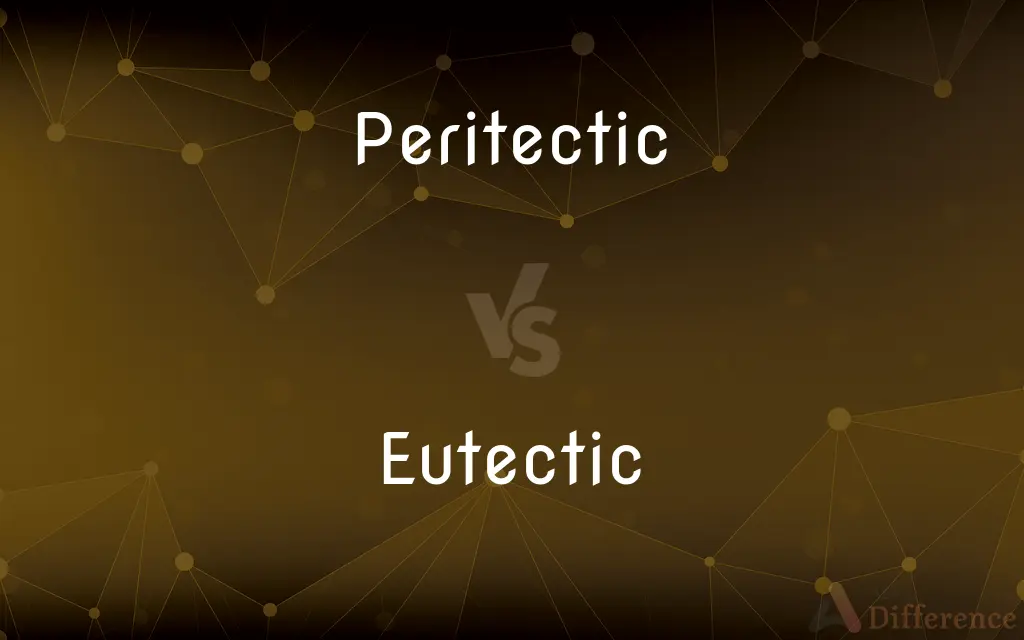Peritectic vs. Eutectic — What's the Difference?
By Urooj Arif & Fiza Rafique — Updated on March 27, 2024
Peritectic reactions involve the melting of a solid upon heating to form a liquid and a second solid phase, while eutectic reactions occur when a liquid cools to form two distinct solid phases simultaneously.

Difference Between Peritectic and Eutectic
Table of Contents
ADVERTISEMENT
Key Differences
In a peritectic reaction, a solid and a liquid phase react upon heating to produce a second, different solid phase. This type of reaction is characterized by a specific composition and temperature at which the transformation occurs, known as the peritectic point. On the other hand, a eutectic reaction describes a process in which a liquid cools and solidifies into two separate solid phases at the same time. This occurs at a specific eutectic composition and eutectic temperature, where the mixture has the lowest melting point.
Peritectic systems are significant in materials science, particularly in alloy development, as they affect the microstructure and properties of the alloy. The key aspect of a peritectic reaction is the transformation that involves both melting and solidification processes depending on the direction of temperature change. Eutectic systems are crucial in understanding the phase behavior of alloys and other mixtures, as they allow for the formation of fine-grained microstructures with unique properties. The hallmark of a eutectic reaction is the simultaneous crystallization of two phases from a liquid, leading to a mixture that often has desirable mechanical, thermal, or electrical properties.
While peritectic systems are characterized by the interaction between solid and liquid phases to form a new solid phase, eutectic systems involve the transformation of a liquid into two distinct solid phases without the intermediate formation of a new phase. The understanding of both reactions is essential for controlling the properties of alloys, ceramics, and other composite materials through thermal processing.
The temperature and composition at which peritectic and eutectic reactions occur are key to their differentiation. Peritectic points represent temperatures above which a solid phase reacts with a liquid to form a different solid phase. Eutectic points, however, represent the lowest possible melting point for a mixture of specific composition, resulting in the simultaneous crystallization of two solids.
In practical applications, the knowledge of peritectic and eutectic reactions allows for the manipulation of material properties. For instance, in alloy development, controlling cooling rates and compositions can optimize mechanical strength or corrosion resistance by exploiting these reactions. This illustrates the importance of understanding phase diagrams and reaction kinetics in materials science and engineering.
ADVERTISEMENT
Comparison Chart
Reaction Type
Solid + liquid → second solid phase
Liquid cools to form two solid phases simultaneously
Occurrence
At the peritectic point, specific temperature and composition
At the eutectic point, lowest melting point for the composition
Significance
Important in alloy development, affecting microstructure and properties
Crucial for creating fine-grained microstructures with unique properties
Phase Change
Involves melting and solidification
Involves simultaneous crystallization of two phases
Practical Use
Manipulation of material properties in alloys and ceramics
Optimization of mechanical, thermal, or electrical properties in alloys
Compare with Definitions
Peritectic
Influential in the development of high-temperature materials.
Peritectic reactions are key in creating ceramics with enhanced thermal stability.
Eutectic
Reaction where a liquid cools to simultaneously form two solids.
The eutectic reaction in the Al-Si system produces a mixture beneficial for casting.
Peritectic
Reaction where a solid and liquid phase form a second solid phase.
The peritectic formation of sigma phase in steel affects its hardness.
Eutectic
Produces fine-grained microstructures.
Eutectic structures in alloys often result in improved mechanical properties.
Peritectic
Occurs at a specific composition and temperature.
At the peritectic point, certain alloys change their microstructural characteristics.
Eutectic
Characterized by the lowest melting point at a specific composition.
Solder is designed to have a eutectic composition for a low melting point.
Peritectic
Involves both melting and solidification.
Peritectic transformation in an alloy can be observed as it heats past its peritectic temperature.
Eutectic
Found in various material systems.
The lead-tin eutectic system is widely used in electronic soldering applications.
Peritectic
Affects material microstructure.
The control of cooling rates during peritectic reaction influences the grain size in the final product.
Eutectic
Utilized to optimize material properties.
Eutectic alloys are selected for thermal management solutions due to their unique melting behavior.
Peritectic
(physics) Describes the isothermal reversible reaction of a liquid phase and a solid phase to form a second solid phase during cooling
Eutectic
Of, relating to, or formed at the lowest possible temperature of solidification for any mixture of specified constituents. Used especially of an alloy whose melting point is lower than that of any other alloy composed of the same constituents in different proportions.
Peritectic
The second solid phase so-formed
Eutectic
Exhibiting the constitution or properties of such a solid.
Eutectic
A eutectic mixture, solution, or alloy.
Eutectic
The eutectic temperature.
Eutectic
Describing the chemical composition or temperature of a mixture of substances that gives the lowest temperature at which the mixture becomes fully molten. A further requirement is that that temperature is lower than the melting point of any of the pure component substances.
Eutectic
(chemistry) Describing the thermodynamic equilibrium conditions where a liquid coexists with two solid phases.
For a mixture with two components at a fixed pressure, the eutectic reaction can only happen at a fixed chemical composition and temperature, called the eutectic point.
Eutectic
A material that has the composition of a eutectic mixture or eutectic alloy
Eutectic
The temperature of the eutectic point
Eutectic
Of maximum fusibility; - said of an alloy or mixture which has the lowest melting point which it is possible to obtain by the combination of the given components.
Eutectic
A mixture of substances having a composition providing the minimum melting point ofr mixtures of those substances. Called also a eutectic mixture.
Eutectic
A mixture of substances having a minimum melting point
Common Curiosities
How do peritectic reactions affect alloy properties?
Peritectic reactions can alter an alloy's microstructure, affecting its mechanical strength, ductility, and other properties.
Why are peritectic and eutectic points important in materials science?
They define specific compositions and temperatures at which materials undergo transformation, crucial for designing materials with desired properties.
What is the main difference between peritectic and eutectic reactions?
The main difference lies in their nature; peritectic reactions involve a solid and a liquid forming a new solid phase, while eutectic reactions involve a liquid cooling to form two solid phases simultaneously.
How do these reactions influence material selection?
Understanding these reactions helps in selecting materials that will exhibit desired properties for specific applications, optimizing performance and cost.
What is a eutectic alloy, and why is it useful?
A eutectic alloy is a mixture of components that solidifies at a lower temperature than its constituents, useful for its unique melting properties and fine microstructure.
Can peritectic and eutectic reactions be controlled?
Yes, through thermal processing techniques such as controlled heating and cooling, the effects of these reactions on materials can be manipulated.
Can a material system have both peritectic and eutectic reactions?
Yes, a material system can exhibit both reactions, depending on its composition and temperature, as seen in complex phase diagrams.
What role does cooling rate play in these reactions?
Cooling rate can affect the microstructure resulting from these reactions, influencing the material's physical and mechanical properties.
What are the practical applications of understanding these reactions?
They are essential in alloy design, ceramic manufacturing, and the development of composite materials, impacting industries from aerospace to electronics.
How is the eutectic composition determined?
The eutectic composition is determined through phase diagram analysis, identifying the composition with the lowest melting point.
Share Your Discovery

Previous Comparison
Nonsale vs. Sale
Next Comparison
Society vs. CultAuthor Spotlight
Written by
Urooj ArifUrooj is a skilled content writer at Ask Difference, known for her exceptional ability to simplify complex topics into engaging and informative content. With a passion for research and a flair for clear, concise writing, she consistently delivers articles that resonate with our diverse audience.
Co-written by
Fiza RafiqueFiza Rafique is a skilled content writer at AskDifference.com, where she meticulously refines and enhances written pieces. Drawing from her vast editorial expertise, Fiza ensures clarity, accuracy, and precision in every article. Passionate about language, she continually seeks to elevate the quality of content for readers worldwide.














































